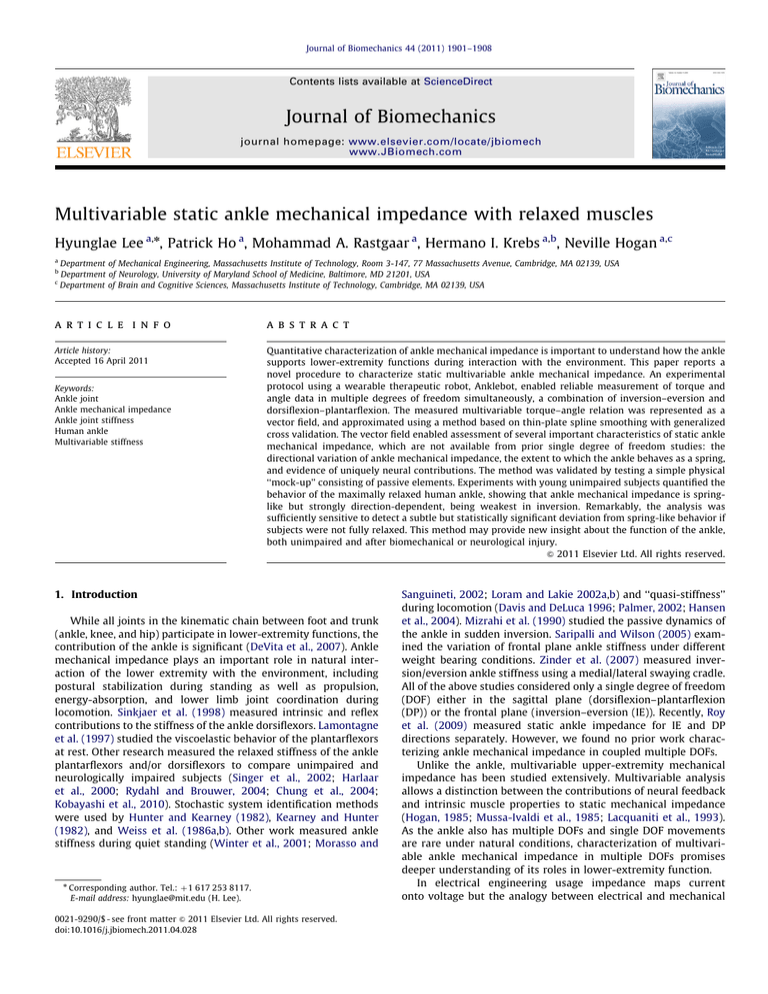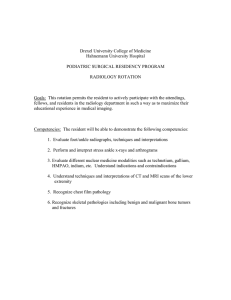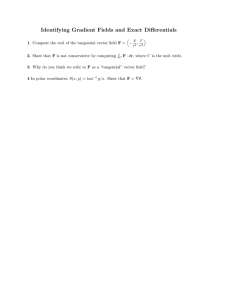
Journal of Biomechanics 44 (2011) 1901–1908
Contents lists available at ScienceDirect
Journal of Biomechanics
journal homepage: www.elsevier.com/locate/jbiomech
www.JBiomech.com
Multivariable static ankle mechanical impedance with relaxed muscles
Hyunglae Lee a,n, Patrick Ho a, Mohammad A. Rastgaar a, Hermano I. Krebs a,b, Neville Hogan a,c
a
b
c
Department of Mechanical Engineering, Massachusetts Institute of Technology, Room 3-147, 77 Massachusetts Avenue, Cambridge, MA 02139, USA
Department of Neurology, University of Maryland School of Medicine, Baltimore, MD 21201, USA
Department of Brain and Cognitive Sciences, Massachusetts Institute of Technology, Cambridge, MA 02139, USA
a r t i c l e i n f o
abstract
Article history:
Accepted 16 April 2011
Quantitative characterization of ankle mechanical impedance is important to understand how the ankle
supports lower-extremity functions during interaction with the environment. This paper reports a
novel procedure to characterize static multivariable ankle mechanical impedance. An experimental
protocol using a wearable therapeutic robot, Anklebot, enabled reliable measurement of torque and
angle data in multiple degrees of freedom simultaneously, a combination of inversion–eversion and
dorsiflexion–plantarflexion. The measured multivariable torque–angle relation was represented as a
vector field, and approximated using a method based on thin-plate spline smoothing with generalized
cross validation. The vector field enabled assessment of several important characteristics of static ankle
mechanical impedance, which are not available from prior single degree of freedom studies: the
directional variation of ankle mechanical impedance, the extent to which the ankle behaves as a spring,
and evidence of uniquely neural contributions. The method was validated by testing a simple physical
‘‘mock-up’’ consisting of passive elements. Experiments with young unimpaired subjects quantified the
behavior of the maximally relaxed human ankle, showing that ankle mechanical impedance is springlike but strongly direction-dependent, being weakest in inversion. Remarkably, the analysis was
sufficiently sensitive to detect a subtle but statistically significant deviation from spring-like behavior if
subjects were not fully relaxed. This method may provide new insight about the function of the ankle,
both unimpaired and after biomechanical or neurological injury.
& 2011 Elsevier Ltd. All rights reserved.
Keywords:
Ankle joint
Ankle mechanical impedance
Ankle joint stiffness
Human ankle
Multivariable stiffness
1. Introduction
While all joints in the kinematic chain between foot and trunk
(ankle, knee, and hip) participate in lower-extremity functions, the
contribution of the ankle is significant (DeVita et al., 2007). Ankle
mechanical impedance plays an important role in natural interaction of the lower extremity with the environment, including
postural stabilization during standing as well as propulsion,
energy-absorption, and lower limb joint coordination during
locomotion. Sinkjaer et al. (1998) measured intrinsic and reflex
contributions to the stiffness of the ankle dorsiflexors. Lamontagne
et al. (1997) studied the viscoelastic behavior of the plantarflexors
at rest. Other research measured the relaxed stiffness of the ankle
plantarflexors and/or dorsiflexors to compare unimpaired and
neurologically impaired subjects (Singer et al., 2002; Harlaar
et al., 2000; Rydahl and Brouwer, 2004; Chung et al., 2004;
Kobayashi et al., 2010). Stochastic system identification methods
were used by Hunter and Kearney (1982), Kearney and Hunter
(1982), and Weiss et al. (1986a,b). Other work measured ankle
stiffness during quiet standing (Winter et al., 2001; Morasso and
n
Corresponding author. Tel.: þ1 617 253 8117.
E-mail address: hyunglae@mit.edu (H. Lee).
0021-9290/$ - see front matter & 2011 Elsevier Ltd. All rights reserved.
doi:10.1016/j.jbiomech.2011.04.028
Sanguineti, 2002; Loram and Lakie 2002a,b) and ‘‘quasi-stiffness’’
during locomotion (Davis and DeLuca 1996; Palmer, 2002; Hansen
et al., 2004). Mizrahi et al. (1990) studied the passive dynamics of
the ankle in sudden inversion. Saripalli and Wilson (2005) examined the variation of frontal plane ankle stiffness under different
weight bearing conditions. Zinder et al. (2007) measured inversion/eversion ankle stiffness using a medial/lateral swaying cradle.
All of the above studies considered only a single degree of freedom
(DOF) either in the sagittal plane (dorsiflexion–plantarflexion
(DP)) or the frontal plane (inversion–eversion (IE)). Recently, Roy
et al. (2009) measured static ankle impedance for IE and DP
directions separately. However, we found no prior work characterizing ankle mechanical impedance in coupled multiple DOFs.
Unlike the ankle, multivariable upper-extremity mechanical
impedance has been studied extensively. Multivariable analysis
allows a distinction between the contributions of neural feedback
and intrinsic muscle properties to static mechanical impedance
(Hogan, 1985; Mussa-Ivaldi et al., 1985; Lacquaniti et al., 1993).
As the ankle also has multiple DOFs and single DOF movements
are rare under natural conditions, characterization of multivariable ankle mechanical impedance in multiple DOFs promises
deeper understanding of its roles in lower-extremity function.
In electrical engineering usage impedance maps current
onto voltage but the analogy between electrical and mechanical
1902
H. Lee et al. / Journal of Biomechanics 44 (2011) 1901–1908
systems has been debated for decades (Hogan and Breedveld,
2008). Mechanical impedance could be defined to map force onto
velocity or vice-versa but neither definition would reflect the
profound role of geometry and kinematics in all aspects of
mechanical system dynamics. We define the term ‘‘mechanical
impedance’’ to be a dynamic operator that maps a time-history of
displacement onto the corresponding force time-history,
Z : xðtÞ-f ðtÞ, where the force and displacement vectors are
energetically conjugate such that they may define mechanical
t
work, dW ¼ f dx.
In this study we identified the static component of multivariable ankle mechanical impedance. We report an experimental
protocol and analysis methods using a wearable robot and a
vector field approximation method. The methods were validated
on a simple physical ‘‘mock-up’’ consisting of passive elements.
Experiments with human subjects provided a precise and sensitive characterization of the multivariable torque–angle relation at
the ankle in IE–DP space as a vector field. This vector field enabled
assessment of several important ankle characteristics: the spatial
structure of ankle impedance, the extent to which the ankle
behaves as a spring, and evidence of uniquely neural contributions. This information may be valuable in orthopedic and
neurological applications, providing a detailed quantitative characterization of ankle mechanics in health for comparison with
biomechanical or neurological disorders.
2. Methods
2.1. Subjects
Eight unimpaired young human subjects with no reported history of biomechanical or neuromuscular disorders (4 males, 4 females; age 22–31; height 1.62–
1.90 m; weight 59.0–84.8 kg) were recruited for this study. Participants gave
written informed consent to participate as approved by MIT’s Committee on the
Use of Humans as Experimental Subjects.
Fig. 1. Subject wearing Anklebot in a seated position.
with pure eversion (01), rotated by 151 on each subsequent perturbation (451
corresponded to equal perturbations in eversion and dorsiflexion) and ended at
3451. Applied torque and actual angular displacement in both DOF as well as EMG
data were sampled at 200 Hz. The complete set of measurements took a little over
3 min.
2.4. Analysis methods
2.2. Experimental setup
The static torque–angle relation was measured for IE and DP simultaneously
using a wearable robot, Anklebot (Interactive Motion Technologies, Inc.) It is
highly back-drivable and provides actively controllable torques up to 15 Nm and
23 Nm in IE and DP, respectively, (Roy et al., 2009) and allows the maximum range
of motion required for the typical gait of healthy or pathological subjects (Perry,
1992). A PD controller for joint angle with proportional gain 100 Nm/rad and
derivative gain 2 Nm-s/rad guaranteed safe, stable, and highly compliant operations in human–robot interactions.
Subjects wore a modified shoe and a knee brace, to which the robot was
connected. Subjects were seated and the knee brace was securely fastened to the
chair to support the weight of the robot and the leg and to ensure that
measurements were made in a repeatable posture (Fig. 1).
To monitor muscle activation levels electromyographic (EMG) signals were
recorded using surface electrodes with a bandpass between 20 and 450 Hz (Delsys
Inc.) placed on the bellies of major muscles related to ankle movement: tibialis
anterior (TA), soleus (SOL), gastrocnemius (GAS), and peroneus longus (PL).
Because ‘‘aliasing’’ due to under-sampling is expected to affect the shape of the
sampled EMG spectrum but not its total variance (Sadhukhan et al., 1994), and to
ensure synchronization with other measurements, EMG was sampled at 200 Hz
and its magnitude was estimated using a root-mean-square filter with a sliding
window of 0.2 s (Clancy and Hogan, 1997).
2.3. Experimental protocol
Subjects were seated with their ankle held by the robot clear of the ground in a
neutral position with the sole at a right angle to the tibia. Subjects were instructed
to relax while Anklebot applied terminated ramp perturbations to the ankle with a
slow velocity (51/s), selected to avoid evoking spindle-mediated stretch reflexes
and maintain quasi-static conditions. Anklebot moved the ankle along a commanded trajectory, and held the foot for 0.1 s at the starting and ending positions.
The complete protocol consisted of 48 movements total along 24 equally spaced
directions in IE–DP space, once outbound and once inbound per direction, with a
nominal displacement amplitude of 201 in each direction. Perturbations began
Any torque components required to overcome the inertia and friction of the
actuators were measured by 10 repetitions of the experimental protocol explained
above but with no human subject. The average of these measurements was
expressed as a multivariable relation between torque and angle and subtracted
from the recorded torque.
A general angular mechanical impedance is a time-varying, multidimensional,
nonlinear, dynamic operator that maps an angular motion time-history onto a
corresponding torque time-history. The time-invariant, static components of ankle
impedance we measured may be represented as a vector field (Eq. (1))
ðtIE , tDP Þ ¼ V ðyIE , yDP Þ
ð1Þ
where yIE and yIE are angular displacements in the IE and DP directions, respectively, and yIE and yIE are the corresponding applied torques. We decomposed the
vector field approximation (V) problem into two scalar function estimation
ðf1 , f2 Þ problems (Eq. (2))
tIE ¼ f1 ðyIE , yDP Þ, tDP ¼ f2 ðyIE , yDP Þ
ð2Þ
For scalar function estimation, we used Thin-Plate Spline (TPS) smoothing with
Generalized Cross Validation (GCV). TPS smoothing provides a surface approximation for each scalar function. In addition, the best fit can be obtained from GCV,
which determines an optimal smoothing parameter to compromise between
fidelity to the data and roughness of the surface. Thus, with the application of
GCV, each scalar function ðf1 , f2 Þ is uniquely determined in the form of a TPS, and
the total vector field (V) can be defined accordingly. Details of TPS smoothing with
GCV are provided in Appendix A. Inbound and outbound data were treated
separately.
To represent the directional variation of static ankle mechanical impedance,
the torque opposing displacement in different directions was calculated from the
friction-compensated nonlinear vector field approximation as follows. For each of
the 48 movements described above (24 outbound, 24 inbound) displacements
up to 201 were imposed and the projection of the torque field directed towards
the origin (co-linear with the displacement) was identified. The straight line
(not constrained to intersect the origin) that best fits this data in a least squares
sense was determined. Its slope represented the effective stiffness opposing
displacement in that direction.
H. Lee et al. / Journal of Biomechanics 44 (2011) 1901–1908
The nonlinear vector field approximation was also decomposed into a
conservative component with zero curl and a rotational component with zero
divergence. The conservative component is spring-like. Here, a set of muscles is
defined as spring-like if the torque vector is an integrable function of displacement
so that a potential function analogous to the elastic energy stored in a spring may
be determined (Hogan, 1985). In that case, the torque vector is the gradient of a
potential function and, as a result, the curl of the torque field must be identically
zero. Spring-like behavior is passive, since no energy is generated or removed by
cyclic displacements. On the other hand, the rotational component is active
because cyclic displacements may add or remove energy. Thus we can quantify
how spring-like the ankle is by comparing the size of the rotational (curl)
component of the field with its conservative component. A detailed definition of
‘‘spring-like’’ and the decomposition method are provided in Appendix B and C,
respectively.
2.5. Physical ‘‘mock-up’’
To validate our methods, the procedure was tested using a simple physical
‘‘mock-up’’. It consisted of two wooden blocks joined by a flexible steel plate and
connected to the Anklebot in the same way as the shoe and knee brace (Fig. 2 left).
To allow for the robot torque limits and prevent plastic deformation of the steel
plate, the nominal angular displacement of this ‘‘mock-up’’ was set as 31, and the
torque–angle data were recorded for movements in 24 directions. Although the
mock-up did not display the same torque–angle relation as the human ankle, it
provided a challenging test of our methods because (i) by design it had strongly
direction-dependent behavior and (ii) its torque–angle relation had zero curl,
because we know from physical principles that any collection of passive elements
(elastic, inertial or frictional), however connected, cannot generate non-zero curl.
3. Results
3.1. Validation of analysis methods
The total vector field measured from the physical mock-up is
shown in Fig. 2. As expected from the geometry of the thin steel
plate connecting the blocks, it was substantially stiffer in IE than
in DP, and this was reflected in the pattern of the vector field. In
addition, whether the torque–angle relation is linear or nonlinear,
because the mock-up was a passive mechanical structure, the
vector field must be conservative. Decomposition of the measured
vector field showed that its curl components were not significantly different from zero (Fig. 2).
If curl is zero in one coordinate frame, it should be zero in all
coordinate frames. We verified this by computing the curl in joint
1903
coordinates and in actuator coordinates, first transforming the
raw data between the two frames through the nonlinear kinematic relations due to the mechanical connection of the Anklebot
to the limb (detailed in Appendix D) then applying the vector field
fitting procedure. Although the shape of the total vector field was
changed by this coordinate transformation, the curl value
remained zero (Fig. 2).
These results showed that our analysis method correctly
identified curl when it was absent. To test whether the method
correctly identified curl when it was present, we simulated a
torque field with non-zero curl and noise comparable to our
experimental data and applied our method to analyze it. The
results (detailed in Appendix E) verified that curl was also
correctly identified when it was present.
3.2. Relaxed static ankle mechanical impedance
Outbound and inbound torque and angular displacement data
were approximated separately (Fig. 3). The data points distributed
in 24 directions are the friction-compensated measurements. The
surfaces are estimates of the two torque components obtained by
TPS approximation with an optimal smoothing parameter determined by GCV. The actual displacement amplitude was about 151
(mean value across 24 directions of all subjects data is 15.331
with standard deviation 1.541), and all data except points near the
starting position (0–11) of each movement direction were used for
scalar function estimation. The mean deviation between measurements and estimates was less than 0.005 Nm with standard
deviation (SD) 0.380 Nm, from which we defined zero deviation
as 0.740–0.750 Nm with 95% confidence. Because of the substantial smoothing effect of the surface fitting procedure used to
identify the vector field, this error was substantially smaller than
the apparatus measurement error range, 71 Nm. (Roy et al.,
2009) Representative 2D slices of the vector field in 4 major
directions (inversion, eversion, dorsiflexion, and plantarflexion)
show how well the field fit the observed data (Fig. 4).
For all subjects, the effective ankle stiffness was calculated
from the estimated vector field in 48 movement directions
(24 outbound, 24 inbound) as detailed above. To check the
validity of this stiffness estimate, we quantified how well
this linearized approximation fit the nonlinear torque field by
Fig. 2. Verification of the vector field approximation using a physical mock-up consisting of passive elements. (Left: physical mock-up setup, Middle: total vector field,
Right: Rotational field with zero curl. Top panels: joint coordinates; Bottom panels: actuator coordinates).
1904
H. Lee et al. / Journal of Biomechanics 44 (2011) 1901–1908
Fig. 3. Representative friction-compensated measurements (depicted as point sets in 24 directions) and the corresponding vector field (consisting of two TPS surface
estimates (|1 ,|2 Þ). Both (a) outbound and (b) inbound data are depicted.
calculating an R2 value. The lowest R2 value was 0.88 and most
subjects showed R2 values higher than 0.90, indicating that the
linearized stiffness accounted for at least 90% of the variance. The
averaged stiffness estimation results of all subjects but one (subject
#6) are plotted in polar coordinates in (Fig. 5(a)). Ankle stiffness
varied significantly with direction in IE–DP space and was consistently lower in the IE direction than in the DP direction, resulting in a
‘‘peanut’’ shape, pinched in the IE direction. Subject #6, who was
excluded from the means presented in Fig. 5(a) had an unusually low
dorsiflexion impedance (9.86 Nm/rad) and an unusually high plantarflexion impedance (33.15 Nm/rad) compared to the mean values of
all other subjects (16.99 Nm/rad for dorsiflexion and 15.71 Nm/rad
for plantarflexion).
The torque required for outbound (loading) movements was
consistently greater than for inbound (unloading) movements,
even after static torques due to Anklebot friction were subtracted
from the measurements. In all 24 directions, this torque was
statistically different from zero (p o0.05). The resulting energy
dissipation was quantified by the area enclosed within the
‘‘hysteresis’’ loop formed by the compensated outbound and
inbound curves of the raw data. The result is graphically depicted
in IE–DP space in Fig. 5(b). Hysteresis was highly correlated with
stiffness (R2 ¼ 0.88) and larger in DP than IE, exhibiting a pinched
‘‘peanut’’ shape.
Decomposition of the vector field into a conservative field
(with zero curl) and a rotational field (with zero divergence)
showed that, in general, the rotational components were much
smaller than the conservative components (Fig. 6). The
mean magnitude of curl and the ratio of the determinants of
the anti-symmetric and symmetric parts of the stiffness matrix
(Kratio ¼det(Kanti-sym)/det(Ksym)) were computed (Hogan, 1985).
Excluding one subject (subject #3, discussed below), the average
magnitude of curl was 0.22 Nm with standard deviation 0.19 Nm,
which was statistically indistinguishable from zero. The mean
value of Kratio for the same 7 subjects was 0.017 (see Table 1 for
details). The ankle joint is predominantly spring-like in the fully
relaxed condition.
One subject (subject #3) exhibited undesired muscle activation during the protocol, apparently being unable to relax fully.
This subject significantly activated tibialis anterior (evident as a
large magnitude of EMG, 0.02 mV) during movements in directions between 2551 and 3451. For comparison, the mean EMG
magnitude for each of four fully relaxed muscles was lower than
0.002 mV. This subject’s muscle activation was accompanied by
non-zero rotational components, notably in the 2551 and 2701
directions (the highlighted region in the right panel of Fig. 7).
Another interesting subject (subject #2) who fell asleep during
the measurement protocol exhibited an average magnitude curl
of 0.13 Nm with standard deviation 0.1 Nm. These were the
smallest values recorded among all subjects.
4. Discussion
Given its importance during interaction with the environment, an accurate characterization of ankle mechanical impedance would be a valuable asset to understand the role of the
ankle in lower-extremity function in health or with biomechanical or neurological disorders. To overcome a limitation of
previous single DOF studies, we developed a novel multivariable
H. Lee et al. / Journal of Biomechanics 44 (2011) 1901–1908
1905
Fig. 4. Representative 2D slices of the vector field in 4 major directions (inversion, eversion, dorsiflexion and plantarflexion): measurements in 4 major directions and the
fitted field (top), projected 2D data in inversion–eversion (mid) and dorsiflexion–plantarflexion (bottom).
Fig. 5. Directional variation of (a) ankle stiffness (Dark solid band: Mean value of outbound and inbound data, Light solid bands: Mean 7 SE, Dotted band: Mean of
outbound data, Dashed band: Mean of inbound data) and (b) hysteresis (Dark solid band: Mean value, Light solid bands: Mean 7 SE) in IE–DP space.
experimental protocol using a wearable therapeutic robot that
enabled fast and reliable measurements of the static ankle
torque–angle relation in IE–DP space.
We used a robust function-approximation method (TPS with
optimal smoothing determined by GCV) to identify the vector
torque–angle relation. This provided a reliable estimate of static
1906
H. Lee et al. / Journal of Biomechanics 44 (2011) 1901–1908
Fig. 6. Decomposition of a representative vector field. The torque vector is represented by an arrow drawn with its tail at the tip of the angular displacement vector
(Red: positive curl, Black: negative curl). (For interpretation of the references to color in this figure legend, the reader is referred to the web version of this article.)
Table 1
Rotational components and effective stiffness in major directions for all subjects.
OUTBOUND
subject
Mean curl
magnitude (Nm)
Curl std. dev.
(Nm)
K_ratio
Stiffness in major directions (Nm/rad)
Inversion
Eversion
Dorsiflexion
Plantarflexion
7.06
8.85
10.39
15.40
11.51
11.67
13.21
4.66
12.33
16.25
24.46
29.65
19.72
9.33
21.02
7.32
14.26
15.41
18.21
15.47
21.11
34.11
11.86
19.74
Eversion
Dorsiflexion
Plantarflexion
6.73
8.09
8.57
12.65
11.63
9.98
11.50
4.82
11.39
14.29
15.44
20.15
16.57
10.38
19.97
9.23
13.45
14.47
11.68
18.51
15.87
32.18
13.17
16.69
1
2
3
4
5
6
7
8
0.17
0.13
0.35
0.22
0.29
0.28
0.23
0.22
0.13
0.10
0.40
0.18
0.19
0.24
0.21
0.24
0.013
0.008
0.041
0.008
0.023
0.029
0.011
0.023
5.35
8.28
11.26
9.91
5.26
6.69
7.83
4.28
INBOUND
subject
Mean curl
magnitude (Nm)
Curl std.
dev. (Nm)
K_ratio
Stiffness in major directions (Nm/rad)
Inversion
1
2
3
4
5
6
7
8
0.19
0.14
0.41
0.29
0.26
0.27
0.24
0.20
0.15
0.13
0.36
0.24
0.21
0.22
0.18
0.19
0.018
0.013
0.068
0.018
0.019
0.022
0.013
0.023
5.35
6.10
9.71
9.00
6.98
7.23
8.99
4.72
Fig. 7. Non-zero curl components (right panel, color code as in Fig. 6) due to undesired muscle activation (left panel). (Red: Tibialis Anterior, Green: Peroneus Longus,
Blue: Soleus, Pink: Gastrocnemius). (For interpretation of the references to color in this figure legend, the reader is referred to the web version of this article.)
ankle mechanical impedance even in the (inevitable) presence of
noisy data. The mean deviation between the estimated vector
field and the raw data was much less than the imprecision of the
measurement system.
Identifying a vector field by treating each vector component as
a scalar field has been challenged by (Mussa-Ivaldi, 1992) who
pointed out that the details of a scalar approximation (e.g., using
the Gaussian radial basis functions) vary with the coordinates
H. Lee et al. / Journal of Biomechanics 44 (2011) 1901–1908
chosen by the experimenter, potentially rendering the structure
of the estimated vector field sensitive to an investigator’s arbitrary choices. We validated our method experimentally using a
simple physical ‘‘mock-up’’ consisting of wooden blocks and a
steel plate. From physical considerations we know that the
rotational component (curl) of the vector torque–angle relation
for the mock-up must be identically zero, and our measurements
confirmed this. In addition, we showed that the conclusion that
curl was zero did not depend on the coordinate frame used to
represent the data. Although the detailed shape of the total vector
field may change when it is represented in different coordinates
(Fig. 2), certain physical properties (such as whether the field is
energetically conservative, with zero curl) must be independent
of coordinates. We verified that the observation of zero curl was
invariant even under nonlinear coordinate transformations.
We quantified the multivariable static ankle mechanical
impedance of healthy young human subjects previously unavailable from single DOF studies. Torque values ðtIE , tDP Þ at any
position ðyIE , yDP Þ were determined from the approximated vector
field and a single effective stiffness opposing displacement in any
direction in IE–DP space was calculated. We found that ankle
stiffness varied substantially with direction. A plot of stiffness vs.
direction exhibited a characteristic ‘‘peanut’’ shape, pinched in
the IE direction. Although ankle stiffness is highly variable even
within a group of young healthy subjects, on average, ankle
stiffness in the DP direction was higher than in the IE direction
by about a factor of 2. The orientation of this ‘‘peanut’’ shape was
not precisely aligned with the anatomical axes, the maximumstiffness direction being consistently tilted slightly from the DP
axis in a counterclockwise direction. These are clinically meaningful results and indicate the direction of rotation in which the
ankle is most vulnerable. Lower frontal plane stiffness indicates a
greater tendency for the foot to roll, especially in inversion.
Perturbations, e.g., from uneven ground, may evoke excessive
displacement and possibly injury of the ankle. This is consistent
with the observation that most ankle-related injuries occur in the
frontal plane rather than in the sagittal plane (O’Donoghue, 1984;
Baumhauer et al., 1995).
We also found that the torque evoked by displacement away
from the equilibrium posture (outbound) was typically greater
than the torque corresponding to the same displacement as the
foot returned towards equilibrium (inbound). As positive network
was required to displace the ankle and return it to equilibrium,
the presence of some dissipative phenomenon is indicated,
similarly observed in the wrist (Rijnveld and Krebs, 2007). As
forces due to static friction or other non-ideal behavior of the
Anklebot were measured prior to the experiments and subtracted
from the recorded data, and the phenomenon varied with direction similarly to ankle stiffness, it appears to be a characteristic of
muscle. Further study seems warranted.
Analysis of the estimated multivariable vector field provided a
precise quantification of the extent to which the ankle is ‘‘springlike’’. Across almost all subjects, curl was indistinguishable from
zero; the ankle was spring-like. Because muscles were relaxed,
this may seem unsurprising. The force–length relation for each
individual muscle resembles a spring (albeit possibly nonlinear)
and any arbitrary connection of spring-like muscles to the
skeleton will yield a spring-like joint behavior (again possibly
nonlinear). However, neural feedback (e.g., from spindles and
Golgi tendon organs) may also contribute to static ankle mechanical impedance. If it does, then inter-muscular feedback between
muscles that act on different degrees of freedom may introduce a
deviation from spring-like behavior (Hogan, 1985). If curl is zero
while inter-muscular feedback is non-zero, then the feedback
gains must be exactly balanced; a dorsi-plantar flexion torque
evoked by an inversion–eversion displacement must be identical
1907
to the inversion–eversion torque evoked by a comparable dorsiplantar flexion displacement. Conversely, with constant muscle
activity, non-zero curl can only be due to unbalanced intermuscular feedback. Spring-like behavior (zero curl) in the presence of non-zero inter-muscular feedback is important because
it would indicate that although the neuromuscular system is
internally complex, it apparently exhibits an externally simple
behavior. Spring-like behavior is consistent with dynamically
passive ankle mechanical impedance, which would help to ensure
stable interaction with a dynamically passive environment
(Hogan, 1986, 1988).
Remarkably, we observed non-zero curl in one alert subject.
This subject showed a small but significantly non-zero activation
of TA and a small but significantly non-zero curl when the foot
was displaced towards plantar flexion, stretching the TA. Movement in other directions evoked zero curl and EMG was silent,
showing that this subject was able to relax fully under our
experimental manipulation. The activation of TA when it was
stretched suggests an involuntary action of neural feedback. If so,
the observation of non-zero curl may be due to unbalanced intermuscular feedback. Work in progress to estimate ankle impedance when muscles are active may clarify the relation between
muscle activation and spring-like behavior. Conversely, our most
relaxed subject (who fell asleep during the measurement procedure) exhibited the smallest curl measured in all subjects. Taken
together, these observations show that vector field approximation
based on scalar methods using TPS smoothing with GCV works
well—sufficiently precise to detect the subtle differences in
structure due to small changes in muscle activation (Fig. 7).
Quantifying the rotational components of static ankle mechanical impedance is important because they are fundamentally nonpassive: unlike the conservative components, under certain conditions, the rotational components may function as an energy
source. Consequently, they may affect the stability of the musculo-skeletal system during posture and locomotion. This may be
especially important in persons with neurological injury (e.g.,
stroke or spinal cord injury). The prevalence of abnormal muscle
tone and spasticity indicates that the peripheral neural networks
may be disordered following neurological injury. This will affect
the static ankle mechanical impedance and, if inter-muscular
feedback is unbalanced, it will manifest as a non-zero rotational
component. We anticipate that this study will serve as a baseline
to explore the ankle mechanical impedance characteristics of
older and neurologically impaired subjects.
Conflict of interest statement
The authors declare that there is no conflict of interest in
this study.
Acknowledgments
This work was funded by Toyota Motor Corporation’s Partner
Robot Division. H. Lee was supported by a Samsung Scholarship.
Drs. N. Hogan and H. I. Krebs are co-inventors of the MIT patents
for the robotic devices used in this study. They hold equity
positions in Interactive Motion Technologies, Inc., the company
that manufactures this type of technology under license to MIT.
Appendix. Supporting information
Supplementary data associated with this article can be found
in the online version at doi:10.1016/j.jbiomech.2011.04.028.
1908
H. Lee et al. / Journal of Biomechanics 44 (2011) 1901–1908
References
Baumhauer, J.F., Alosa, D.M., Renstrom, P.A.F.H., Trevino, S., Beynnon, B., 1995.
A prospective study of ankle injury risk factors. The American Journal of Sports
Medicine 23, 564–570.
Clancy, E.A., Hogan, N., 1997. Relating agonist–antagonist electromyograms
to joint torque during isometric, quasi-isotonic, nonfatiguing contractions.
IEEE Transactions on Biomedical Engineering 44 (10), 1024–1028.
Chung, S.G., Rey, E., Bai, Z., Roth, E.J., Zhang, L.-Q., 2004. Biomechanic changes in
passive properties of hemiplegic ankles with spastic hypertonia. Archives of
Physical Medicine and Rehabilitation 85 (10), 1638–1646.
Davis, R., DeLuca, P., 1996. Gait characterization via dynamic joint stiffness.
Gait and Posture 4 (3), 224–231.
DeVita, P., Helseth, J., Hortobagyi, T., 2007. Muscles do more positive than negative
work in human locomotion. Journal of Experimental Biology 210 (19),
3361–3373.
Hansen, A.H., Childress, D.S., Miff, S.C., Gard, S.A., Mesplay, K.P., 2004. The human
ankle during walking: implication for design of biomimetic ankle prosthesis.
Journal of Biomechanics 37 (10), 1467–1474.
Harlaar, J., Becher, J., Snijders, C., Lankhorst, G., 2000. Passive stiffness characteristics of ankle plantar flexors in hemiplegia. Clinical Biomechanics 15 (4),
261–270.
Hogan, N., 1985. The mechanics of multi-joint posture and movement control.
Biological Cybernetics 52 (5), 315–331.
Hogan, N., 1986. Multivariable mechanics of the neuromuscular system. In:
Proceedings of the 8th Annual Conference of the IEEE Engineering in Medicine
Biology Society, 594–598.
Hogan, N., 1988. On the stability of manipulators performing contact tasks. IEEE
Journal of Robotics and Automation 4 (6), 677–686.
Hogan, N., Breedveld, P.C., 2008. The physical basis of analogies in physical system
models, The Mechatronics Handbook: Mechatronic Systems, Sensors, and
Actuators 2nd ed. CRC Press Chapter 16.
Hunter, I.W., Kearney, R.E., 1982. Dynamics of human ankle stiffness: variation
with mean ankle torque. Journal of Biomechanics 15 (10), 747–752.
Kearney, R.E., Hunter, I.W., 1982. Dynamics of human ankle stiffness: variation
with displacement amplitude. Journal of Biomechanics 15 (10), 753–756.
Kobayashi, T., Leung, A.K.L., Akazawa, Y., Tanaka, M., Hutchins, S.W., 2010.
Quantitative measurements of spastic ankle joint stiffness using a manual
device: a preliminary study. Journal of Biomechanics 43 (9), 1831–1834.
Lacquaniti, F., Carrozzo, M., Borghese, N.A., 1993. Time-varying mechanical
behavior of multijointed arm in man. Journal of Neurophysiology 69 (5),
1443–1464.
Lamontagne, A., Malouin, F., Richards, C.L., 1997. Viscoelastic behavior of plantar
flexor muscle-tendon unit at rest. The Journal of Orthopaedic and Sports
Physical Therapy 26 (5), 244–252.
Loram, I.D., Lakie, M., 2002a. Human balancing of an inverted pendulum: position
control by small, ballistic-like, throw and catch movements. The Journal of
Physiology 540 (3), 1111–1124.
Loram, I.D., Lakie, M., 2002b. Direct measurement of human ankle stiffness during
quiet standing: the intrinsic mechanical stiffness is insufficient for stability.
The Journal of Physiology 545 (3), 1041–1053.
Mizrahi, J., Ramot, Y., Susak, Z., 1990. The passive dynamics of the subtalar joint in
sudden inversion of the foot. ASME Journal of Biomechanical Engineering 112,
9–14.
Morasso, P.G., Sanguineti, V., 2002. Ankle muscle stiffness alone cannot stabilize
balance during quiet standing. Journal of Neurophysiology 88 (4), 2157–2162.
Mussa-Ivaldi, F.A., 1992. From basis functions to basis fields: vector field
approximation from sparse data. Biological Cybernetics 67 (6), 479–489.
Mussa-Ivaldi, F.A., Hogan, N., Bizzi, E., 1985. Neural, mechanical, and geometric
factors subserving arm posture in humans. The Journal of Neuroscience 5 (10),
2732–2743.
O’Donoghue, D.H., 1984. Treatment of Injuries to Athletes. Saunders Company,
Philadelphia.
Palmer, M., 2002. Sagittal plane characterization of normal human ankle function
across a range of walking gait speeds. MS Thesis, Massachusetts Institute of
Technology, Cambridge.
Perry, J., 1992. Gait Analysis: Normal and pathologic functions. Slack Inc, New
Jersey.
Rijnveld, N., Krebs, H.I., 2007. Passive wrist joint impedance in flexion – Extension
and Abduction – Adduction. In: Proceedings of the IEEE 10th International
Conference on Rehabilitation Robotics, Netherland.
Roy, A., Krebs, H.I., Williams, D.J., Bever, C.T., Forrester, L.W., Macko, R.M., Hogan,
N., 2009. Robot-aided neurorehabilitation: a robot for ankle rehabilitation.
IEEE Transactions on Robotics 25 (3), 569–582.
Rydahl, S.J., Brouwer, B.J., 2004. Ankle stiffness and tissue compliance in stroke
survivors: a validation of myotonometer measurements. Archives of Physical
Medicine and Rehabilitation 85 (10), 1631–1637.
Sadhukhan, A.K., Goswami, A., Kumar, A., Gupta, S., 1994. Effect of sampling
frequency on EMG power spectral characteristics. Electromyography and
Clinical Neurophysiology 34 (3), 159–163.
Saripalli, A., Wilson, S., 2005. Dynamic ankle stability and ankle orientation. In:
Proceedings of the 7th Symposium on Footwear Biomechanics, Cleveland, USA.
Singer, B., Dunne, J., Singer, K., Allison, G., 2002. Evaluation of triceps surae muscle
length and resistance to passive lengthening in patients with acquired brain
injury. Clinical Biomechanics 17 (2), 151–161.
Sinkjaer, T., Toft, E., Andreassen, S., Honemann, B.C., 1998. Muscle stiffness in
human ankle dorsiflexors: intrinsic and reflex components. Journal of Neurophysiology 60 (3), 1110–1121.
Weiss, P.L., Kearney, R.E., Hunter, I.W., 1986a. Position dependence of ankle joint
dynamics—I. Passive mechanics. Journal of Biomechanics 19 (9), 727–735.
Weiss, P.L., Kearney, R.E., Hunter, I.W., 1986b. Position dependence of ankle joint
dynamics—II. Active mechanics. Journal of Biomechanics 19 (9), 737–751.
Winter, D.A., Patla, A.E., Rietdyk, S., Ishac, M.G., 2001. Ankle muscle stiffness in the
control of balance during quiet standing. Journal of Neurophysiology 85 (6),
2630–2633.
Zinder, S.M., Granata, K.P., Padua, D.A., Gansneder, B.M., 2007. Validity and
reliability of a new in vivo ankle stiffness measurement device. Journal of
Biomechanics 40 (2), 463–467.







